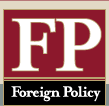
Foreign Policy
Hitting Them Where It Works
By Theodore Postol
Whether or not one believes that the threat from emerging missile states such as Iran, Iraq, or North Korea is serious enough to require deployment of a national missile defense (NMD), it makes no sense for the Clinton administration to advocate a defense concept that not only will fail to work against these countries but also will provoke negative reactions from Russia and China. But there is a way to provide a defense that would likely be effective and also much less provocative to Moscow and Beijing. A “boost-phase” missile defense—jointly built and operated by Russia and the United States”would target intercontinental ballistic missiles (ICBMs) in their first few minutes of flight, while they are still being accelerated up to speed by their rocket engines. This strategy differs from the planned NMD, which is a mid-course system that can easily be defeated by countermeasures released from target ICBMs after they end powered flight. A boost-phase defense could only be devastating from a relatively short range and only over a relatively small region of the earth (to a range of perhaps a thousand kilometers). Consequently, the system would be unstoppable when used against geographically small emerging missiles states, but it could neither be effective against, nor expanded to defend against, missiles launched from geographically vast countries such as Russia or China. This boost-phase missile defense would consist of very fast interceptors placed in hardened underground silos or on offshore platforms at distances of hundreds of kilometers from North Korean, Iranian, or Iraqi launch sites. Silos might be deployed in the region near Vladivostok (to defend against North Korean launches) or in Turkey, Azerbaijan, or the Caspian Sea (to defend against Iranian launches).
When an ICBM is launched, it would be detected and tracked by sensors placed on the ground, in unmanned airborne vehicles or aircraft, or on satellites orbiting the earth. The missile defense system would then launch boost-phase interceptors that would accelerate to 8 to 8.5 kilometers per second in a little over a minute. Even if the launch of the interceptors were delayed for a minute or more after the launch of an ICBM in order to establish its trajectory, the interceptors could still destroy the ICBM while it was in powered flight, causing its warhead to fall far short of its target.
Unlike the Clinton administration’s proposed system, this boost-phase defense would be difficult to counter. Countries seeking to defeat it might try to reduce the boost-phase flight time, thereby narrowing the window of opportunity for a successful intercept. But that would require the development of highly advanced solid propellant ballistic-missile technology—an innovation that is in a completely different league than the liquid-fueled Scud-missile technology that is now the foundation for the missile programs of states such as North Korea, Iran, and Iraq. Moreover, in contrast to the administration’s proposed mid-course NMD system, this boost-phase system could destroy an ICBM before it released submunitions carrying biological or chemical agents. In addition, the technology needed to implement this defense is far less demanding than that needed for mid-flight intercepts. Because boost-phase interceptors would only need to detect the very hot plume of the booster and not the cooler warhead or decoys, such interceptors could use higher resolution short-wavelength sensors that are easier to build and much less costly than the long-wavelength sensors used by the kill vehicles of the planned NMD system. The ICBM booster target is large and would be destroyed by a hit almost anywhere, so the probability of a successful intercept would be very high.
A boost-phase defense system would face significant policy obstacles. Getting countries such as Azerbaijan or Turkey to allow basing of interceptors on their territory could be a challenge. Such a program would also require close cooperation between Russia and the United States, which would increase existing Chinese concerns about a U.S.-Russian alliance. Moreover, a boost-phase defense deployment near North Korea would be able to intercept long-range missiles launched from a relatively small part of China.
Perhaps more serious, however, would be Chinese concerns that the boost-phase defense could be turned into a mid-course defense capable of intercepting ICBMs launched from anywhere in their country. China could easily build countermeasures to deal with such a contingency, and Russia and the United States could implement transparency measures to reassure China, but the possibility that the system could be rapidly modified might remain a concern. However, these problems are all far more manageable than those raised by the administration’s planned NMD system. Even the first phase of the administration’s fragile and easily defeated NMD will create serious problems with both Russia and China—and may well lead to the collapse of the entire international regime of arms control treaties.
Theodore Postol is professor of science, technology, and national security policy at the Massachusetts Institute of Technology.